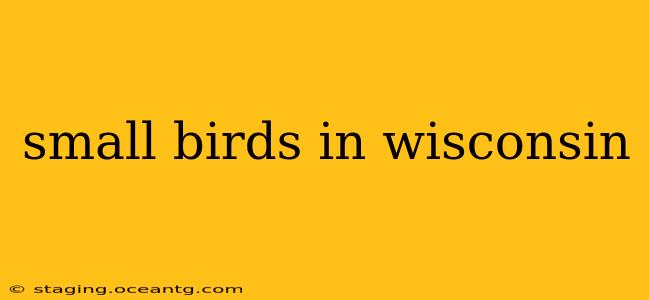Wisconsin, with its diverse habitats ranging from lush forests to expansive prairies and shimmering lakes, is home to a vibrant array of bird species. While identifying every feathered friend might seem daunting, focusing on the smaller birds offers a manageable and rewarding birding experience. This guide will explore some of the common small birds you're likely to encounter in Wisconsin, along with helpful identification tips and interesting facts.
What are some common small birds found in Wisconsin?
This question forms the core of our exploration. Wisconsin's small bird population is incredibly diverse, but some species are more commonly sighted than others. These include:
- Chickadees (Black-capped and Carolina): These tiny, energetic birds are easily recognizable by their black caps, white cheeks, and cheerful calls. Black-capped Chickadees are more prevalent across the state, while Carolina Chickadees are found in the southern regions.
- Tufted Titmice: Slightly larger than chickadees, tufted titmice boast a distinctive crest on their heads and a gray-brown back. Their soft "peter-peter-peter" call is another key identifier.
- Downy Woodpeckers: These are the smallest woodpeckers in Wisconsin, with a black and white checkered pattern. They frequently forage on tree trunks and branches for insects.
- House Wrens: Known for their bouncy, energetic movements and loud, chattering songs, house wrens are common in wooded areas and around human settlements.
- Ruby-crowned Kinglets: These tiny, active birds are often overlooked, but their olive-green plumage and distinctive reddish crown (visible only when they raise their crest) make them fascinating to observe.
- Golden-crowned Kinglets: Similar in size and activity to Ruby-crowned Kinglets, these birds have a yellow stripe through the crown. They often migrate through Wisconsin in the fall and spring.
- Brown Creepers: These inconspicuous birds are masters of camouflage, blending seamlessly with tree bark as they spiral upwards, searching for insects. Their thin, down-curved bill is a key identification feature.
What are the smallest birds in Wisconsin?
Determining the absolute smallest bird can be tricky as size can vary slightly within a species. However, the Ruby-crowned Kinglet and Golden-crowned Kinglet are consistently ranked among the smallest birds found in Wisconsin, measuring just under 4 inches in length.
What are some of the easiest small birds to identify in Wisconsin?
For beginning birdwatchers, some of the easiest small birds to identify are those with distinct markings and calls. Chickadees and Tufted Titmice stand out due to their readily identifiable markings and vocalizations. The Downy Woodpecker's size and coloration also make it relatively easy to distinguish from other woodpeckers.
Where can I find small birds in Wisconsin?
Small birds can be found in a variety of habitats across Wisconsin. Woodlands, parks, backyards, and even urban areas all provide suitable habitats for various species. Consider visiting locations with diverse vegetation, offering foraging opportunities and shelter. Remember to be respectful of wildlife and maintain a safe distance for observation.
What is the best time of year to see small birds in Wisconsin?
While many small birds are resident year-round, the best time to see the greatest variety is during spring and fall migration. This is when numerous species pass through Wisconsin on their journeys north and south. Summer months also provide ample opportunity to observe breeding birds and their young.
What are some tips for attracting small birds to my backyard?
Creating a bird-friendly backyard is a rewarding experience. Providing food sources like bird feeders (with a variety of seeds), fresh water, and natural cover such as shrubs and trees will attract a range of small birds. Avoid using pesticides and herbicides, as these can harm birds and their food sources.
This guide provides a starting point for exploring the fascinating world of small birds in Wisconsin. With a little patience and observation, you'll soon be able to identify and appreciate the beauty and diversity of these captivating creatures. Remember to consult field guides and utilize online resources like the Cornell Lab of Ornithology's All About Birds website for more in-depth information and identification assistance. Happy birding!
